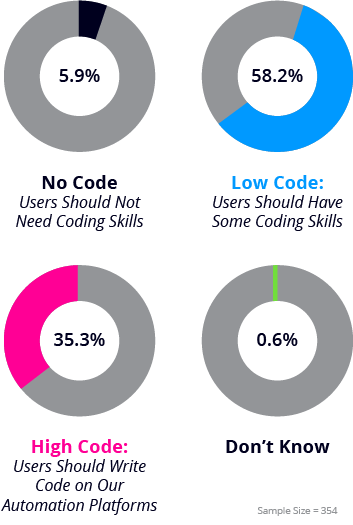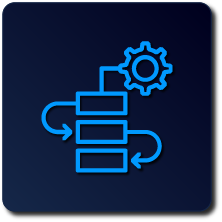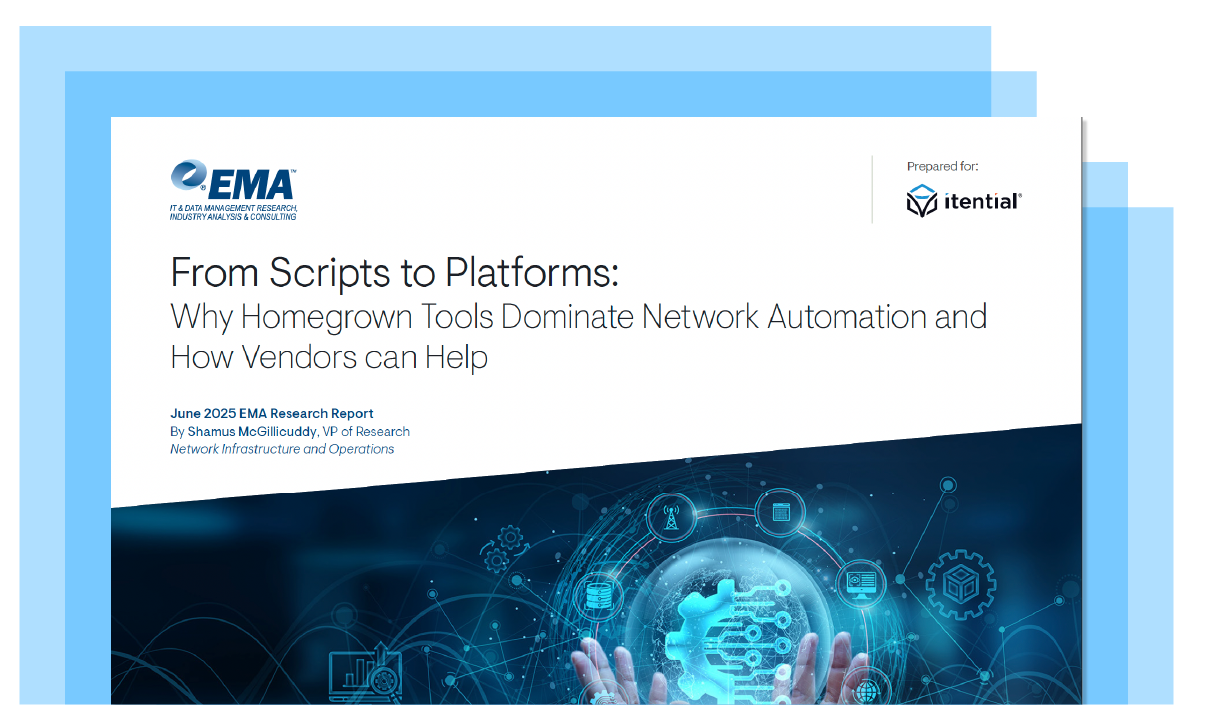EMA’s latest research reveals why scripts dominate network automation today and how teams can move beyond them to achieve orchestration, consistency, and self-service delivery.

Join the Live Webinar with EMA + Armstrong
Key Report Insights
- 64% of enterprises use homegrown software or scripts to automate their networks.
- Teams spend 6+ hours a week maintaining and debugging DIY tooling.
- 64% of IT leaders are actively seeking low- or no-code platforms to standardize and scale automation.
- Security, compliance, and governance are key drivers pushing orgs to adopt platforms.
- Platforms that integrate and extend existing homegrown automation — rather than rip-and-replace — are seen as the ideal solution.
The Great Divide: Why Scripts Rule the Trenches, But Platforms Hold the Future
The EMA research reveals a split perspective within organizations: network engineers favor homegrown scripts and open-source playbooks for their flexibility and control, while IT leadership sees commercial platforms as essential for consistency, security, and scalability. Scripting and open source remain the go-to solutions for immediate needs and niche use cases, but as demands for orchestration, governance, and cross-team visibility grow, leadership is pushing for modular, extensible platforms that can integrate — not replace — what teams have already built. This tension reflects a deeper truth: the future of network automation is not about choosing between DIY and commercial platforms — it’s about bridging them.
This tension between daily engineering needs and broader leadership goals shapes how automation evolves across the enterprise.
 Practitioner Reality
Practitioner Reality
61% of network teams taking a DIY approach to automation spend six or more hours each week maintaining and debugging these tools.
 IT Leadership View
IT Leadership View
64% of IT organizations are seeking low- or no-code network automation solutions to drive standardization and scale.

Why Scripts & Playbooks Remain the Default for Engineers
While engineering teams continue to rely heavily on code-heavy approaches for network automation, EMA’s research found that many IT leaders want to see another path forward. In fact, 64% of IT organizations are actively looking for low- or no-code solutions to drive standardization and scale. Yet homegrown automation efforts — by nature — remain high-code and labor-intensive, requiring constant development and refinement as needs evolve.

Struggle to sell IT leadership on commercial tools.

Value scripts for flexibility and customization.

See commercial tools as too centralized and rigid.

Believe open source & free tools are trusted industry standards.
When Scripts Start to Strain: The Limits of DIY Automation
While homegrown scripts and tools help network teams tackle immediate challenges, they’re not without serious hurdles. The EMA report reveals that even engineers deeply committed to scripting acknowledge the growing pains: from skill gaps and tool complexity to maintenance headaches and security risks. As networks scale, these challenges threaten to slow progress and erode the very flexibility that makes homegrown solutions attractive in the first place.
The Human Capital Gap
Building and managing code-heavy automation requires engineers with a rare blend of network and development skills — talent that’s hard to find and retain.
Maintenance & Security Risks
Supporting and securing homegrown automation is an uphill battle, especially as original builders move on or documentation gets lost.
Tool & Project Complexity
DIY tools grow messy over time. Poor documentation, inconsistent processes, and ad-hoc fixes make it harder to sustain progress.
Usability Issues & Fragile Toolchains
Most homegrown solutions rely on scripts strung together manually, which break easily when used in unintended ways.
Unexpected Use Cases
Tools built for one job often get pressed into others — and that mismatch leads to failures and confusion.
The Power of Platforms:
Turning Scripts Into Scalable Operations
While homegrown scripts and playbooks offer control and flexibility, the EMA research shows that platforms play a critical role in taking automation to the next level. By centralizing governance, providing security, and enabling integration, platforms help teams transform one-off scripts into coordinated, scalable workflows that work across the enterprise.
![]() The key isn’t to abandon homegrown tools — it’s to bring them together in a way that makes them more secure, reliable, and sustainable.
The key isn’t to abandon homegrown tools — it’s to bring them together in a way that makes them more secure, reliable, and sustainable.
![]()
I would like a platform to onboard my scripts, stitch them together, and wrap them in a nice package. I don’t have to tell people to go log into a Linux server and run an Ansible playbook. Instead, they get this nicely named workflow with a nice GUI, and you’ll see little boxes turn green as it progresses through the steps.
![]() Senior Network Engineer with a Midsized U.S. Financial Technology Company
Senior Network Engineer with a Midsized U.S. Financial Technology Company
Many network automation engineers want to bring their homegrown tools to vendor platforms and that security, compliance, and platform requirements, like stability and scalability, are the biggest factors.
Which of the following are the most compelling reasons to adopt commercial network automation solutions, as opposed to DIY network automation?
How Platforms Operationalize Home Grown Automation
![]()
I want extensibility without proprietary vendor nonsense. Whatever integrations they give me out of the box, I should be able to create my own and I should be able to stitch them together through a standard language, like Python. I should not have to learn a proprietary vendor language or system. This makes it intuitive to anyone else who knows Python. If I get hit by a bus, my organization won’t have much trouble hiring someone who can take over and continue running it.
![]() Senior Network Engineer with a Midsized U.S. Financial Technology Company
Senior Network Engineer with a Midsized U.S. Financial Technology Company
Armstrong Level’s Up Python-Centric Automation with Itential Platform
The EMA report features Armstrong’s journey as they scaled from Python scripts to orchestrated, self-service network services. By using Itential, Armstrong didn’t have to abandon their existing work — they brought their scripts into a secure, modular environment and grew them into coordinated workflows that could be exposed through self-service APIs. The result? Significant time savings, faster delivery of network services, and a more strategic approach to infrastructure automation.

We didn’t want to rip out everything we built. Itential gave us a way to bring it all together, make it secure, and deliver it as a product.
![]()
Eric Anderson
Senior Infrastructure Architect, Armstrong World Industries
Key Outcomes
From Scripts to Services: Operationalizing Network Automation at Scale with Itential
Itential delivers a modular automation and orchestration platform that helps network and infrastructure teams evolve from homegrown scripts and fragmented tooling to secure, scalable, and integrated automation. Instead of requiring teams to replace what they’ve already built, Itential enhances it, providing the automation execution, orchestration and self-service capabilities needed to mature network automation into a strategic capability.
 Operationalize Your Automation:
Operationalize Your Automation:
Execute with Control
 Orchestrate for Scale:
Orchestrate for Scale:
Connect and Standardize Workflows
 Deliver Network Services as Products:
Deliver Network Services as Products:
Enable Self-Service
 From Automation Projects
From Automation Projects
to Scalable Operations
Ready to Learn More?

Get Started with Itential
Schedule a Custom Demo
Schedule time with our automation experts to explore how our platform can help simplify and accelerate your automation journey.
Take An Interactive Tour
See how Itential products work firsthand in our interactive tours.
Watch Demo Videos
Watch demos of Itential's suite of network automation and orchestration products.

